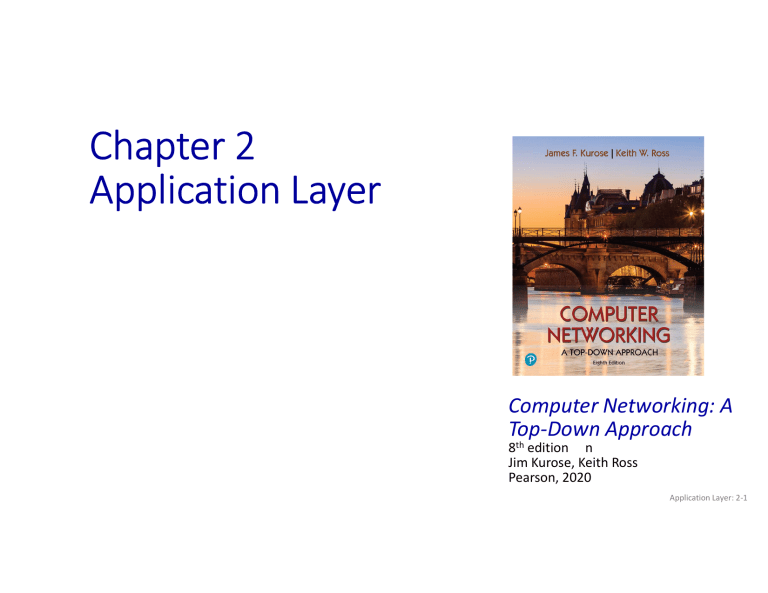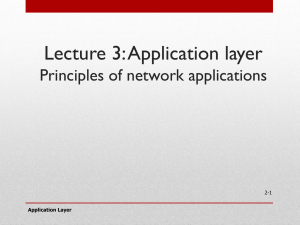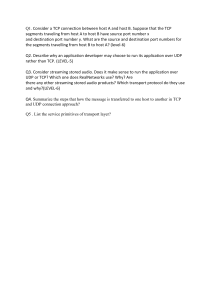
Chapter 2 Application Layer Computer Networking: A Top-Down Approach 8th edition n Jim Kurose, Keith Ross Pearson, 2020 Application Layer: 2-1 Application layer: overview Principles of network applications Web and HTTP E-mail, SMTP, IMAP The Domain Name System DNS P2P applications video streaming and content distribution networks socket programming with UDP and TCP Application Layer: 2-2 Application layer: overview Our goals: conceptual and implementation aspects of application-layer protocols • transport-layer service models • client-server paradigm • peer-to-peer paradigm learn about protocols by examining popular application-layer protocols and infrastructure • HTTP • SMTP, IMAP • DNS • video streaming systems, CDNs programming network applications • socket API Application Layer: 2-3 Some network apps social networking Web text messaging e-mail multi-user network games streaming stored video (YouTube, Hulu, Netflix) P2P file sharing voice over IP (e.g., Skype) real-time video conferencing (e.g., Zoom) Internet search remote login … Q: your favorites? Application Layer: 2-4 Creating a network app write programs that: run on (different) end systems communicate over network e.g., web server software communicates with browser software no need to write software for network-core devices network-core devices do not run user applications applications on end systems allows for rapid app development, propagation application transport network mobile network data link physical national or global ISP local or regional ISP home network application transport network data link physical content provider network datacenter application network transport network data link physical enterprise network Application Layer: 2-5 Client-server paradigm server: always-on host permanent IP address often in data centers, for scaling clients: contact, communicate with server may be intermittently connected may have dynamic IP addresses do not communicate directly with each other examples: HTTP, IMAP, FTP mobile network national or global ISP local or regional ISP home network content provider network datacenter network enterprise network Application Layer: 2-6 Peer-peer architecture no always-on server arbitrary end systems directly communicate peers request service from other peers, provide service in return to other peers • self scalability – new peers bring new service capacity, as well as new service demands mobile network national or global ISP local or regional ISP home network peers are intermittently connected and change IP addresses • complex management example: P2P file sharing content provider network datacenter network enterprise network Application Layer: 2-7 Processes communicating process: program running within a host within same host, two processes communicate using inter-process communication (defined by OS) processes in different hosts communicate by exchanging messages clients, servers client process: process that initiates communication server process: process that waits to be contacted note: applications with P2P architectures have client processes & server processes Application Layer: 2-8 Sockets process sends/receives messages to/from its socket socket analogous to door • sending process shoves message out door • sending process relies on transport infrastructure on other side of door to deliver message to socket at receiving process • two sockets involved: one on each side application process socket application process transport transport network network link physical Internet link controlled by app developer controlled by OS physical Application Layer: 2-9 Addressing processes to receive messages, process must have identifier host device has unique 32-bit IP address Q: does IP address of host on which process runs suffice for identifying the process? A: no, many processes can be running on same host identifier includes both IP address and port numbers associated with process on host. example port numbers: • HTTP server: 80 • mail server: 25 to send HTTP message to gaia.cs.umass.edu web server: • IP address: 128.119.245.12 • port number: 80 more shortly… Application Layer: 2-10 An application-layer protocol defines: types of messages exchanged, • e.g., request, response message syntax: • what fields in messages & how fields are delineated message semantics • meaning of information in fields rules for when and how processes send & respond to messages open protocols: defined in RFCs, everyone has access to protocol definition allows for interoperability e.g., HTTP, SMTP proprietary protocols: e.g., Skype, Zoom Application Layer: 2-11 What transport service does an app need? data integrity some apps (e.g., file transfer, web transactions) require 100% reliable data transfer other apps (e.g., audio) can tolerate some loss timing some apps (e.g., Internet telephony, interactive games) require low delay to be “effective” throughput some apps (e.g., multimedia) require minimum amount of throughput to be “effective” other apps (“elastic apps”) make use of whatever throughput they get security encryption, data integrity, … Application Layer: 2-12 Transport service requirements: common apps application file transfer/download e-mail Web documents real-time audio/video streaming audio/video interactive games text messaging data loss throughput elastic no loss elastic no loss elastic no loss loss-tolerant audio: 5Kbps-1Mbps video:10Kbps-5Mbps loss-tolerant same as above loss-tolerant Kbps+ elastic no loss time sensitive? no no no yes, 10’s msec yes, few secs yes, 10’s msec yes and no Application Layer: 2-13 Internet transport protocols services TCP service: UDP service: reliable transport between sending and receiving process flow control: sender won’t overwhelm receiver congestion control: throttle sender when network overloaded connection-oriented: setup required between client and server processes does not provide: timing, minimum throughput guarantee, security unreliable data transfer between sending and receiving process does not provide: reliability, flow control, congestion control, timing, throughput guarantee, security, or connection setup. Q: why bother? Why is there a UDP? Application Layer: 2-14 Internet applications, and transport protocols application file transfer/download e-mail Web documents Internet telephony streaming audio/video interactive games application layer protocol FTP [RFC 959] SMTP [RFC 5321] HTTP 1.1 [RFC 7320] SIP [RFC 3261], RTP [RFC 3550], or proprietary HTTP [RFC 7320], DASH WOW, FPS (proprietary) transport protocol TCP TCP TCP TCP or UDP TCP UDP or TCP Application Layer: 2-15

